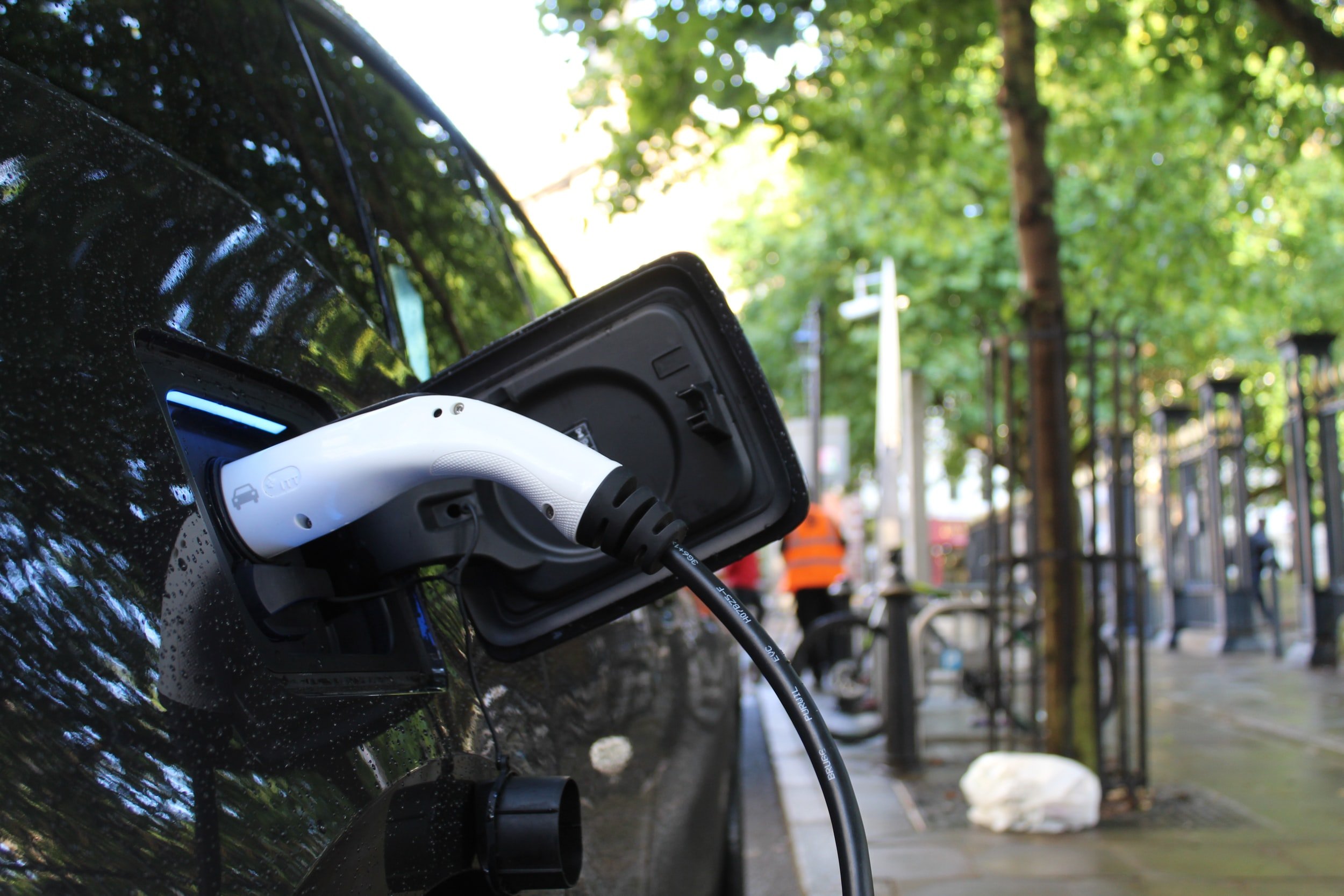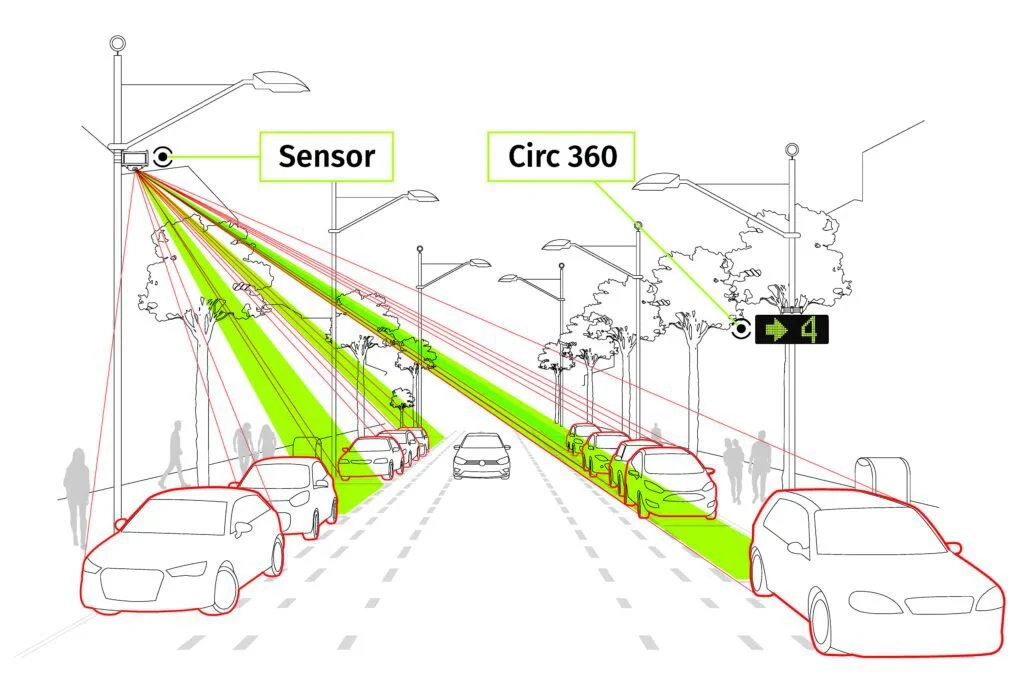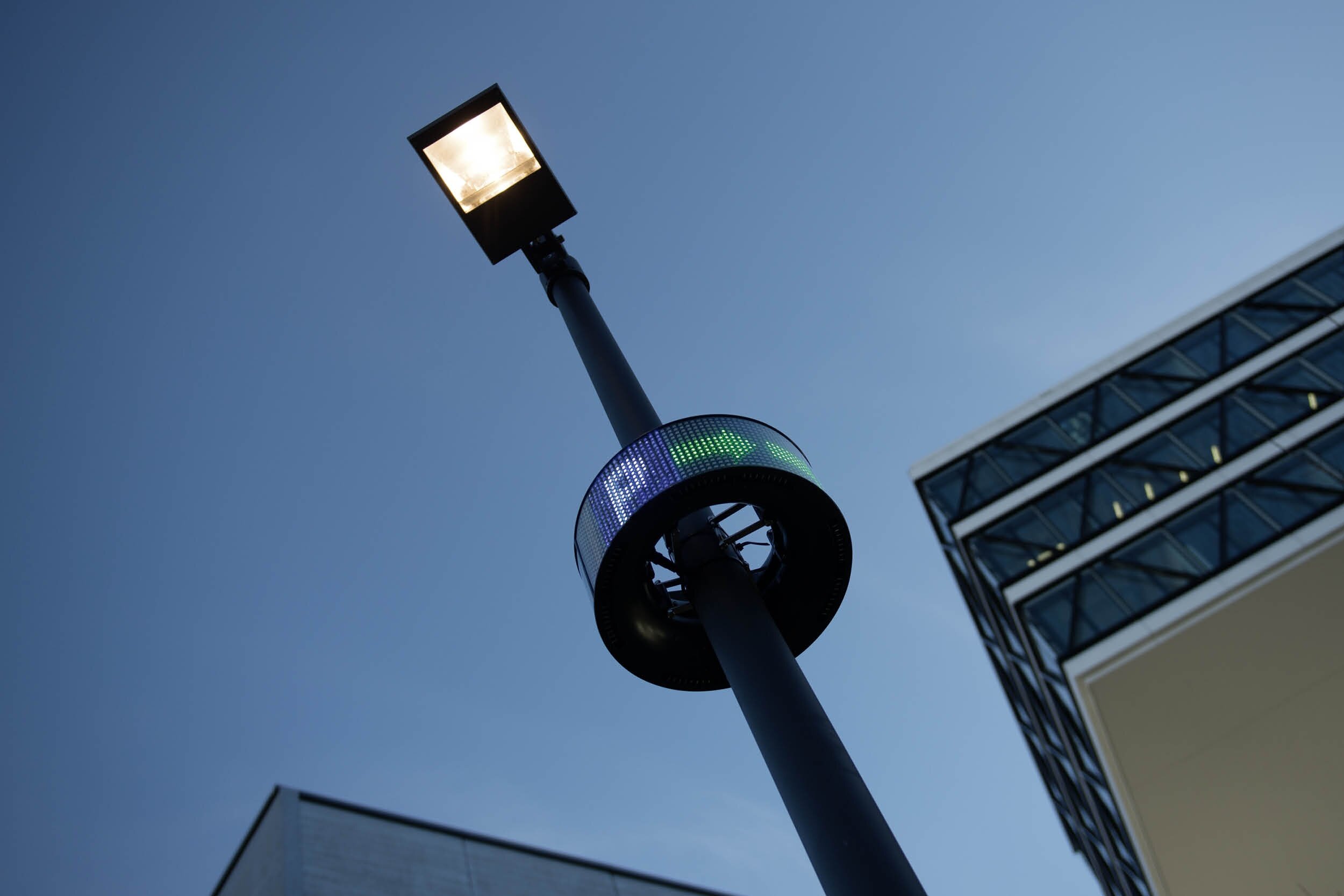Smart cities need to be accessible to all, and that includes those who drive electric vehicles (EVs), especially as they continue to rise in popularity. EV drivers using public chargers frequently encounter a problem: their app or car thinks the charger is available, while in reality the charging space is occupied by a vehicle that is not charging, has finished charging, or is occupied by a car with an internal combustion engine (ICE). The EV industry has even coined a term for this practice, “ICEing”.
ICEing significantly reduces the utilization of publicly accessible urban EV chargers. This reduces revenue for the charging companies and increases frustration for EV drivers seeking a charge. EV chargers are usually subsidized by governments so ICEing also wastes those public funds.
Cleverciti helps its clients reduce ICEing and maximize utilization of EV chargers by monitoring the usage of EV parking spaces both on-street and off-street. Cleverciti’s sensors provide real-time occupancy detection using industry-leading artificial intelligence (AI) technology to determine if an EV charger has an available parking space. That data is married to the charging status reported by the EV charger itself. Municipalities and/or the charging company are able to access this occupancy status via the Cleverciti Cockpit, where they’ll be able to see a bird’s eye view of usage of all chargers. The accurate availability status of each charger can then be published to EV drivers via standard charging apps, giving drivers the confidence they will find an available space.
This innovative approach to ICEing has already shown tremendous success in the German city of Düsseldorf. To help solve for ICEing, the city receives violation alerts any time a vehicle has been parked in a dedicated EV space, without charging, for at least 10 minutes. This could be either a vehicle that arrives and doesn’t start charging in the first 10 minutes, or a vehicle that has finished charging but remains parked after 10 minutes. The municipality then has the information necessary to enforce correct usage of these spaces, for example by issuing a warning or fine. Data obtained over 3 months in Düsseldorf identified an average of 1.25 violations per charger per day (40 per month). Each of these violations represents lost use of a public asset – the EV Charger – because a vehicle is blocking it while not charging, lost charging revenue, and EV driver frustration.
As the world races to deploy EV chargers, Cleverciti stands ready to support cities and EV charging companies to maximize the utilization of those chargers and to guide EV drivers to available charging spaces.
Book a demo now to see how Cleverciti can help you.
We love to say that parking hasn’t changed in 100 years. Until Smart Parking, finding a parking space has always been based on pure luck. Will I find a pole to tie my horse up to? Will I find a parking spot to park my car? But then Smart Parking came along and revolutionized parking completely. It started out with simple ground sensors and moved to sophisticated overhead sensors that eliminated the element of luck. Smart Parking as we know it has evolved into ingenious sensory guidance systems, leading drivers effortlessly to the nearest available parking spot, while saving time and money, improving quality of life, and reducing emissions substantially. Pretty impressive, wouldn’t you say? We’ve come a long way, and we are confident there is a lot more to come. But first, let’s look back at how it all started.
Above mentioned milestones have influenced (smart) parking directly. But, of course, that were more important milestones that indirectly played a role in the development of smart parking as well. 1886, for example, is regarded as the birth year of the modern car when German inventor Karl Benz patented his Benz Patent-Motorwagen. By 1900 mass production of cars was well underway in France and the US. Without the existence of cars, no smart parking. In 1920, forerunners of automated parking systems (APS) appeared for the first time in big American cities like LA, Chicago, New York, and Cincinnati. The Paternoster system, as is depicted in the image above, was applied for the first time in real-life on Chicago’s Monroe Street in 1932. Between 1940 and 1950 the US built more and more APS, some of them still in use today, such as Bowser, Pigeon Hole and Roto Park. In 1951, the first-ever driverless parking garage was built in Washington D.C. The UK followed in 1961, when the Auto Stacker is installed in Woolwich, London, which was - at that point - still quite hard to operate.
The US interest in APS lessened slightly in the 90s, while more technically advanced APS appear in Europe, Asia and Central America. In the late 90s, Japan even became the world-leading production country for APS with over 100,000 automated parking spaces per year.
Early 2000, the (smart) parking sensor technology is really starting to take off, especially in malls and shopping centers. The first robotic garage is build in 2002 in Hoboken, New Jersey. Simultaneously, the use of GPS for smart parking solutions is mentioned in scientific research for the first time.
The history of Cleverciti
In 2012, Cleverciti enters the smart parking stage, initially under the name of “Schlauerparken”. Three years in, the company has already grown a lot, more and more people have joined the team and the company needs a more international name to better fit the international ambitions of the team. First international clients of Cleverciti go live, including Dubai in the UAE.
In 2016, Cleverciti got awarded with Deloitte’s prestigious Technology Fast 50 Award and over a dozen other international awards, for their innovative parking solutions using high-tech sensors. Cleverciti launches the world’s most comprehensive turn-by-turn guidance solution in Cologne, Germany, in 2020. Early 2021, a smart tourism project in Lübeck Bay that includes Cleverciti’s smart parking guidance system gets awarded with the Deutscher Tourismuspreis 2020.
And the best is yet to come….
More information about Cleverciti’s history can be found here.
Want to have a chat with one of our smart parking experts about what the future of smart parking looks like? Schedule a demo below.
Last Wednesday, on April 14th, our CEO Thomas Hohenacker & COO David Parker spoke Sofa Summits - Smart City Summit on:
"The Fastest Path to a 15-minute City. How Cologne Cut Parking Search by 45% to Minimise Congestion"
The talk, as part of the Sustainable Cities - Transportation and Mobility Track, was focused on one of the world’s most innovative and modern parking guidance systems for residents and visitors that was installed in the Cologne district of Nippes last year. The first results of the project have shown parking search time decrease by 45%.
We were joined by a long list of leading and innovative smart cities, such as the City of Rome, Hannover, Barcelona, Amsterdam, Zürich, Helsinki, Rotterdam, Göteborg, Dortmund, Winterthur, Lahti, Geneva, Dublin and Madrid, to name a few.
During the event, several overall polls were released for all attendees to weigh in on - when asked what was the main goal for their smart city, 50% of the respondents answered with ‘sustainability’, 47.1% with ‘quality of life’ and 2.9% with ‘innovation’.
We are happy to see major smart cities prioritizing sustainability and citizen quality of life — 2 facets we have seen improve quickly with the deployment of smart parking, like the case in Cologne.
We’d like to thank all attendees for joining and for their active participation, and for making the event successful.
If you missed it, but would like to hear more about the installation in Cologne, please find the presentation deck or watch the live session recording below.
Read the slide deck that was used during the presentation:
Or watch the full recording:
This year’s edition of the world-renowned tourism fair ITB Berlin took place online from March 9th to March 12th. On March 10th, Cleverciti and the Tourism Association of the Lübeck Bay took the stage on Expo Stage 2 to talk about our successful project in one of Germany’s most touristic regions on the North Coast, where we tackled the high traffic increase in summer with an ingenious smart parking system that benefits both tourists and locals. The speaker panel consisted of Thomas Hohenacker, CEO and Founder at Cleverciti, David Parker, COO at Cleverciti and Paul Stellmacher, Deputy Board Member of Tourism Association “Lübecker Bucht”.
“Successfully Managing Overtourism with an Award-Winning Parking Guidance solution”
As will be touched on later, this has turned out to be an exceptionally successful project for all parties involved.
After short introductions, the speakers kicked off by briefly sharing the challenge at hand:
Lübeck Bay is a top regional tourism destination, only 1 hour away from Hamburg
It has 3 million annual visitors of which 1.5 million day visitors are drawn towards the beautiful beaches
The area is filled with overcrowded hotspots with lead to massive congestion
There is actually plenty of free parking space in lesser-known areas along the coast
All of this was exacerbated by COVID as local tourism and social distancing became the number one priority.
To solve these challenges, a traffic light system was deployed for the beaches and the surrounding parking areas, within an app called “Strandticker.de”. With Strandticker, visitors get steered to “green” areas and steered away from “red” and “yellow” areas. How? By showing a traffic light on a map of the tourism area. The data for the traffic lights come from beach occupancy sensors, installed at all entry points to the beaches, and parking occupancy sensors, installed at all parking areas along the beach. The acceptance of this app has been absolutely overwhelming! Since the launch in 2020, a staggering 400,000 unique users adopted the app with 4 million views within the app store.
Reduce parking search
As for parking specifically, the main challenge in Lübeck Bay was to steer cars directly to the nearest and best parking space, instead of visitors driving to one of the most known parking areas, just to find there is no space anymore and then parking in illegal areas instead.
As said, this led to a simple “traffic light” system for both the beaches and the parking spots, where the visitors can see the exact occupancy status at a glance, quickly finding available parking and make better decisions on their way to the beach. The parking sensors are updated in near real-time which means that a few seconds after the car has parked, the sensor marks the spot as ‘taken’.
Award-winning solution
This concept recently won two coveted Deutscher Tourismuspreis 2020 awards - 2nd Prize overall, and the People’s Choice Award. Reason enough for all parties involved to expand the system regionally!
Future expansion
Next year, the system will be expanded to cover more locations within Scharbeutz and more cities throughout Lübeck Bay. In addition to that, more digital guidance will be added at key decision points to cover 100% of the driver experience in the area. And last but not least, the currently isolated data sources will be combined together to establish a predictive element: “If I leave Hamburg now, will there still be space in 1 hour?” Cleverciti is thrilled to partner with Lübeck Bay on this project and is looking forward to what is still to come.
After the audience learned a bit more about the project and its success, a few more questions came up in the Q&A section:
Why was parking guidance so important in solving the challenge at Lübeck Bay?
Though it is not often said, parking search actually is an immense cost to society, as is shown by these (rather shocking) numbers:
6.8 billion hours per year are wasted due to parking search,
28 million metric tons CO2 is emitted per year (that’s 1.3 billion trees!) due to parking search,
132 billion dollars are lost per year and,
30% of all traffic is unnecessary*.
*In the US, UK & Germany alone.
Source: Innix Parking Pain Study & Donald Shoup: “The High Cost of Free Parking”
Why Cleverciti?
The next question was: why did the Tourism Association pick Cleverciti to handle their parking challenge? Cleverciti, as is illustrated by the case in Lübeck Bay, offers an accurate, real-time, per-space detection system in combination with turn-by-turn guidance to the nearest space. How? By using Cleverciti Sensors & Cleverciti Circ 360®. Each is easy to install and compatible with all public safety and privacy concerns as the sensors only transfer the GPS location of the cars. Also, both are installed on existing infrastructure, which reduces deployment costs.
What is unique about Cleverciti’s parking guidance system?
What makes Cleverciti stand out among other suppliers, is our system combines all existing parking data, meaning, not only data from garages but also on-street and off-street parking. This is the key factor to reducing traffic & emissions.
Where can you currently find Cleverciti’s parking guidance systems?
Cleverciti is operational in 20 countries around the world. Also in major tourism destinations: in the heart of Dubai, Banff Canada, and now also in Lübeck Bay to name a few. The sensors and digital signage have therefore proven themselves to perform equally well in all types of environments and weather conditions.
Wrapping up
After answering a few more questions from the audience, Mr. Stellmacher had one final thought he wanted to share with the audience:
“Visitor guidance systems using parking sensors; it’s very simple, they just work. It’s existing technology put together in a new way that is worth your consideration.”
Interested to learn more about the project in Lubeck Bay? Read our recently published case study going into detail on the project.
Or watch the full ITB presentation below:
From the invention of the first parking meters, parking technology has come a long way, allowing today’s users to independently navigate the entire parking experience. As technologies continue to advance and parking behavior changes, smart parking is bound to evolve as well. Let’s take a look at the smart parking developments we can expect to see in the future.
Increased Efficiency of Parking Systems
The present generation of parking systems offers basic automation, offering users information on the occupancy status of parking spaces and enabling automated ticketing and payment. Within the next ten years, however, users will expect an increase in the efficiency of parking systems. This will entail, among other things, direct guidance to an available parking space and real-time information about other mobility solutions in the vicinity.
2. Growing Shared Mobility Market
As much as 50% of current car owners predict that shared mobility services will replace private car ownership—mainly because car sharing is, in many cases, cheaper and more sustainable. The shared mobility market is expected to be valued at $619.5 billion by 2025, which is bound to also impact smart parking.
3. Including Increasing Mobility Mix in Smart Parking
As transportation systems become more and more integrated, parking operators will have to take a variety of transport options into account. Drivers will need accurate and real-time information on mobility solutions ranging from cars and ride-shares to scooters, public transport, and bicycles.
4. Reducing Emissions with Smart Parking Systems
As cities around the world set out to reduce their harmful emissions, smart parking will be an increasingly important part of environmental initiatives. Deploying a citywide smart parking solution is the fastest way a city can reduce its traffic congestion—and with that, its emissions. Other changes such as a switch to more electric vehicles or more efficient air conditioning and building insulation require many years of changes in consumer behavior, while smart parking shows its effects almost overnight.
5. Increasing Analysis of and Need for Parking Data
As parking requirements change, parking operators will have to analyze changes in parking behavior. In-depth analyses require data. Smart parking systems will therefore not only have to provide reliable services to users but also generate accurate data on parking behaviors, peak hours, etc.
6. Restructuring Parking Spaces to Accommodate Autonomous Vehicles
With the rise of autonomous vehicles, parking spaces will have to be replanned and restructured to accommodate their needs that differ from those of conventional vehicles. They will change the usage of cars in general and parking modalities in particular with their self-parking features and robotic valet parking.
Download our full guide to smart cities and the future of smart parking by clicking the button below.
Smart parking is an efficient and cost-effective system to monitor the availability of parking spaces in real-time. Technologies such as sensors and cameras detect free parking spaces and direct drivers to the most convenient spot via digital signage such as LED-displays. By leveraging the power of artificial intelligence, edge computing, and interconnectivity, the complexity of driving in a complicated environment is simplified.
Benefits of smart parking solutions
Smart parking solutions not only significantly minimize search traffic, but also help ease congestion in cities and reduce vehicle emissions. Finding a free parking space easily in an often-confusing commercial car park enhances customer experience, thus improving revenue. Simultaneously, parking operators and civic authorities can gather intelligent data on parking and customer habits that can be used to drive future infrastructure developments.
Generating data easily
Data is generated via in-ground sensors that have to be installed in each parking space or via Overhead sensors as developed by Cleverciti. The latter can be easily mounted on existing infrastructure such as lampposts or buildings and provide a comprehensive real-time overview of the occupancy status of up to 100 parking spaces per sensor.
Overhead sensors scan the vicinity and identify the position of a parked car or an empty parking space while also measuring the length of an available parking space and registering whether vehicles have been in an illegal space (e.g. in front of a fire hydrant or other no-parking zone).
The data gathered by these sensors is transmitted via cellular (LTE), Wi-Fi or wired Internet connection. The best smart parking solutions process data “at the edge”, which means the only data leaving the sensor itself is the GPS coordinates of a parking space and its availability. This approach ensures compliance with all the relevant data privacy regulations.
Real-time parking information
Relevant insights can then be passed on to drivers via a mobile application, website or digital signage. LED displays such as Cleverciti’s Circ360™ and Circ180™, both of which are multi-directional LED signs that can be installed on existing lampposts, show live parking information and messaging.
Parking meters can be integrated into the system, showing parking operators whether time-limits are being observed.
See how smart parking works in a city environment in the video below:
Interested in learning more about smart city parking solutions? Click the button below to schedule a demo with a smart parking expert now.
We analyzed 634 smart parking solutions for smart cities. Cleverciti, Smart Parking, Parkwise, Stanley Robotics, and PayBySky are our 5 picks to watch out for. Learn more in our Global Startup Heat Map below.
Our innovation analysts recently looked into emerging technologies and up-and-coming startups working on solutions for smart cities. As there is a large number of startups working on a wide variety of solutions, we decided to share our insights with you. This time, we are taking a look at 5 promising smart parking solutions.
Heat map: 5 top smart parking startups
For our 5 top picks, we used a data-driven startup scouting approach to identify the most relevant solutions globally. The Global Startup Heat Map below highlights 5 interesting examples out of 634 relevant solutions. Depending on your specific needs, your top picks might look entirely different.
Which companies develop the other 629 smart parking solutions?
CLEVERCITI – SMART SPACE-MONITORING PARKING SENSORS (SSMPS)
With a growing population in cities, parking lots often have a lack of free spaces. By using smart space-monitoring parking sensors and generating real-time data on parking-spot occupancy, drivers can navigate to the nearest open spot. Data collected from SSMPS can also be used for further optimization of city traffic and parking pricing policies. The same information can be used to maximize revenue by detecting overstays and directing more drivers to underused spaces. Cleverciti from Germany offers a sensor solution that systematically gathers information on available and occupied parking spaces in real-time. Each sensor covers up to 30 parking spaces, and they can be mounted on lamp posts, buildings or masts without requiring roadworks. It generates updated data every 3 seconds and has a night time mode as well – without the need for additional lighting or infrared.
SMART PARKING – SMART PAYMENT FOR PARKING
Drivers often get stuck in parking lots, chasing pay stations or spending a vast amount of time searching for change. Cashless payment solutions are reducing the time for payment and make the procedure more convenient for Smart City citizens. Parking lot owners and city utilities are benefiting from automatic mobile payments too, as they save money on parking pay stations. The single-click-to-pay technology developed by Smart Parking from Belgium supports over 250 worldwide payment methods that are used to substitute payment terminals on parking lots. Their API can be used with any existing Parking Management System.
PARKWISE – REAL-TIME PARKING GUIDANCE SOFTWARE
Searching for free parking spots oftentimes causes additional movements and traffic on the streets. Drivers leave one parking area and start looking for another one, without even knowing if parking slots are available. With the usage of the Internet of Things (IoT) and real-time parking guidance software, drivers are able to communicate with each other and find empty parking spots faster, thus reducing the chance of possible traffic jams. The US-based company Parkwise develops a phone application using artificial intelligence (AI), which connects drivers through their smartphones, so they are helping each other to find empty parking spots easier. Furthermore, when a driver is about to leave their parking spot, the application notifies other drivers about the free parking space.
STANLEY ROBOTICS – AUTOMATED VALET PARKING
In large crowded spaces, like airports or shopping malls, people more likely to spend a huge amount of time searching for free parking spaces. Automated valet parking systems allow drivers to leave their vehicles in a special spot, where a valet take over and park the vehicle tight, in an efficient way. Stan, the robotic valet, by the French company Stanley Robotics, is able to control all types of cars, at a maximum length of 6m, and can easily handle a 3-ton load. The robot is equipped with artificial intelligence which allows it to optimize parking lot space. Stan moves autonomously and adapts to different obstacles that might be in its way.
PAYBYSKY – PARKING BY SATELLITE
Municipal authorities face the problem of privately owned vehicles that are occupying public spaces. One way to resolve this issue is to use accurate satellite vehicle positioning algorithms and a built-in database of parking locations, time, prices, and rules including exceptions. The UK-based PayBySky’s satellite services are starting and stopping parking transactions automatically, so drivers only pay for the minutes they use. As a virtual, cloud-based parking payment system, PayBySky is easily implemented by Smart City authorities to control parking revenue and collect parking data.
WHAT ABOUT THE OTHER 629 SOLUTIONS?
While we believe data is key to creating insights it can be easy to be overwhelmed by it. Our ambition is to create a comprehensive overview and provide actionable innovation intelligence for your Proof of Concept (PoC), partnership, or investment targets. The 5 startups showcased above are promising examples out of 634 we analyzed for this article.
Want to see how smart parking can work for you? Book a demo now:

















